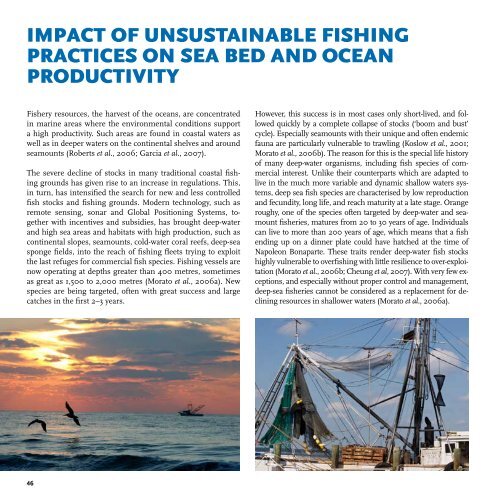In Dead Water: Merging of climate change with - UNEP
In Dead Water: Merging of climate change with - UNEP
In Dead Water: Merging of climate change with - UNEP
Create successful ePaper yourself
Turn your PDF publications into a flip-book with our unique Google optimized e-Paper software.
IMPACT OF UNSUSTAINABLE FISHING<br />
PRACTICES ON SEA BED AND OCEAN<br />
PRODUCTIVITY<br />
Fishery resources, the harvest <strong>of</strong> the oceans, are concentrated<br />
in marine areas where the environmental conditions support<br />
a high productivity. Such areas are found in coastal waters as<br />
well as in deeper waters on the continental shelves and around<br />
seamounts (Roberts et al., 2006; Garcia et al., 2007).<br />
The severe decline <strong>of</strong> stocks in many traditional coastal fishing<br />
grounds has given rise to an increase in regulations. This,<br />
in turn, has intensified the search for new and less controlled<br />
fish stocks and fishing grounds. Modern technology, such as<br />
remote sensing, sonar and Global Positioning Systems, together<br />
<strong>with</strong> incentives and subsidies, has brought deep-water<br />
and high sea areas and habitats <strong>with</strong> high production, such as<br />
continental slopes, seamounts, cold-water coral reefs, deep-sea<br />
sponge fields, into the reach <strong>of</strong> fishing fleets trying to exploit<br />
the last refuges for commercial fish species. Fishing vessels are<br />
now operating at depths greater than 400 metres, sometimes<br />
as great as 1,500 to 2,000 metres (Morato et al., 2006a). New<br />
species are being targeted, <strong>of</strong>ten <strong>with</strong> great success and large<br />
catches in the first 2–3 years.<br />
However, this success is in most cases only short-lived, and followed<br />
quickly by a complete collapse <strong>of</strong> stocks (‘boom and bust’<br />
cycle). Especially seamounts <strong>with</strong> their unique and <strong>of</strong>ten endemic<br />
fauna are particularly vulnerable to trawling (Koslow et al., 2001;<br />
Morato et al., 2006b). The reason for this is the special life history<br />
<strong>of</strong> many deep-water organisms, including fish species <strong>of</strong> commercial<br />
interest. Unlike their counterparts which are adapted to<br />
live in the much more variable and dynamic shallow waters systems,<br />
deep sea fish species are characterised by low reproduction<br />
and fecundity, long life, and reach maturity at a late stage. Orange<br />
roughy, one <strong>of</strong> the species <strong>of</strong>ten targeted by deep-water and seamount<br />
fisheries, matures from 20 to 30 years <strong>of</strong> age. <strong>In</strong>dividuals<br />
can live to more than 200 years <strong>of</strong> age, which means that a fish<br />
ending up on a dinner plate could have hatched at the time <strong>of</strong><br />
Napoleon Bonaparte. These traits render deep-water fish stocks<br />
highly vulnerable to overfishing <strong>with</strong> little resilience to over-exploitation<br />
(Morato et al., 2006b; Cheung et al, 2007). With very few exceptions,<br />
and especially <strong>with</strong>out proper control and management,<br />
deep-sea fisheries cannot be considered as a replacement for declining<br />
resources in shallower waters (Morato et al., 2006a).

















